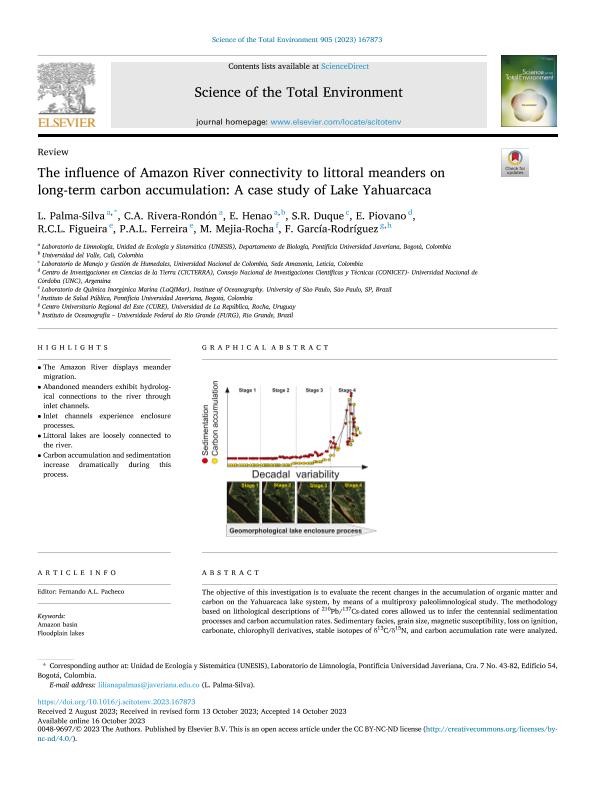Mostrar el registro sencillo del ítem
dc.contributor.author
Palma Silva, L.
dc.contributor.author
Rivera Rondón, C.A.
dc.contributor.author
Henao, E.
dc.contributor.author
Duque, S.R.
dc.contributor.author
Piovano, Eduardo Luis

dc.contributor.author
Figueira, R.C.L.
dc.contributor.author
Ferreira, P.A.L.
dc.contributor.author
Mejia Rocha, M.
dc.contributor.author
García Rodríguez, F.
dc.date.available
2024-03-11T15:47:17Z
dc.date.issued
2023-12
dc.identifier.citation
Palma Silva, L.; Rivera Rondón, C.A.; Henao, E.; Duque, S.R.; Piovano, Eduardo Luis; et al.; The influence of Amazon River connectivity to littoral meanders on long-term carbon accumulation: A case study of Lake Yahuarcaca; Elsevier; Science of the Total Environment; 905; 167873; 12-2023; 1-14
dc.identifier.issn
0048-9697
dc.identifier.uri
http://hdl.handle.net/11336/230071
dc.description.abstract
The objective of this investigation is to evaluate the recent changes in the accumulation of organic matter and carbon on the Yahuarcaca lake system, by means of a multiproxy paleolimnological study. The methodology based on lithological descriptions of 210Pb/137Cs-dated cores allowed us to infer the centennial sedimentation processes and carbon accumulation rates. Sedimentary facies, grain size, magnetic susceptibility, loss on ignition, carbonate, chlorophyll derivatives, stable isotopes of δ13C/δ15N, and carbon accumulation rate were analyzed. LANDSAT and photographic record of satellite images were used to reconstruct the historical geomorphological evolution of the Lake. Sediment cores yielded basal ages of 1827 and 1828 Common Era, representing the formation of lakes as a consequence of the Amazon meandering process. Two main paleolimnological stages were identified, with a boundary transition set at 1980?1984 Common Era, attributed to the geomorphological closure and complete lake separation from the Amazon and the onset of full lentic conditions. This inference was mainly based on both sharp increases in the sedimentation rate from 0.2 to >1 cm yr−1 and carbon accumulation that increased seven-fold (from 2 to 14 g m-2 yr−1) from 1980 to 1984 Common Era. The flood-pulse and connection to the Amazon defined the magnitude of organic inputs, where areas more distant/isolated from the river showed higher accumulation of carbon from autochthonous production, with an average of 8.9 % and 1.10 g m−2 yr−1 (carbon accumulation rate). Those areas closer and connected to the river were strongly related to the interannual hydrological variability, with a lower mean carbon content (5.9 %) and 0.73 g m−2 yr−1 (carbon accumulation rate). We concluded that carbon burial was highest within the most distant spot from the Amazon River because of the weaker connection to the river itself and the more stable lentic conditions for net sedimentation.
dc.format
application/pdf
dc.language.iso
eng
dc.publisher
Elsevier

dc.rights
info:eu-repo/semantics/openAccess
dc.rights.uri
https://creativecommons.org/licenses/by-nc-nd/2.5/ar/
dc.subject
AMAZON BASIN
dc.subject
FLOODPLAIN LAKES
dc.subject
PALEOLIMNOLOGY
dc.subject
RIVER FLOODING
dc.subject.classification
Geociencias multidisciplinaria

dc.subject.classification
Ciencias de la Tierra y relacionadas con el Medio Ambiente

dc.subject.classification
CIENCIAS NATURALES Y EXACTAS

dc.title
The influence of Amazon River connectivity to littoral meanders on long-term carbon accumulation: A case study of Lake Yahuarcaca
dc.type
info:eu-repo/semantics/article
dc.type
info:ar-repo/semantics/artículo
dc.type
info:eu-repo/semantics/publishedVersion
dc.date.updated
2024-03-11T11:37:38Z
dc.identifier.eissn
1879-1026
dc.journal.volume
905
dc.journal.number
167873
dc.journal.pagination
1-14
dc.journal.pais
Países Bajos

dc.journal.ciudad
Amsterdam
dc.description.fil
Fil: Palma Silva, L.. Pontificia Universidad Javeriana; Colombia
dc.description.fil
Fil: Rivera Rondón, C.A.. Pontificia Universidad Javeriana; Colombia
dc.description.fil
Fil: Henao, E.. Pontificia Universidad Javeriana; Colombia. Universidad del Valle; Colombia
dc.description.fil
Fil: Duque, S.R.. Universidad Nacional de Colombia; Colombia
dc.description.fil
Fil: Piovano, Eduardo Luis. Consejo Nacional de Investigaciones Científicas y Técnicas. Centro Científico Tecnológico Conicet - Córdoba. Centro de Investigaciones en Ciencias de la Tierra. Universidad Nacional de Córdoba. Facultad de Ciencias Exactas Físicas y Naturales. Centro de Investigaciones en Ciencias de la Tierra; Argentina
dc.description.fil
Fil: Figueira, R.C.L.. Universidade de Sao Paulo; Brasil
dc.description.fil
Fil: Ferreira, P.A.L.. Universidade de Sao Paulo; Brasil
dc.description.fil
Fil: Mejia Rocha, M.. Pontificia Universidad Javeriana; Colombia
dc.description.fil
Fil: García Rodríguez, F.. Universidad de la Republica; Uruguay. Universidade Federal do Rio Grande; Brasil
dc.journal.title
Science of the Total Environment

dc.relation.alternativeid
info:eu-repo/semantics/altIdentifier/doi/http://dx.doi.org/10.1016/j.scitotenv.2023.167873
dc.relation.alternativeid
info:eu-repo/semantics/altIdentifier/url/https://www.sciencedirect.com/science/article/pii/S0048969723065002
Archivos asociados
